The path to corporate responsibility – understanding the spirit of corporate social responsibility
Ten years ago, discussions were focused on environment and social impacts and sustainable development. From environment and social responsibility, we have now moved to sustainable growth. Although an increasing number of global companies have come to recognise that corporate responsibility goes beyond the ‘good corporate citizenship’ and is a matter for strategic debate. But still this concept seems to be nascent in Pakistan.
In pursuit of harnessing social improvements, firms the world over are involved in various activities. We have outlined these approaches taken, to evaluate the ongoing trend in corporate responsibility approach as given below:
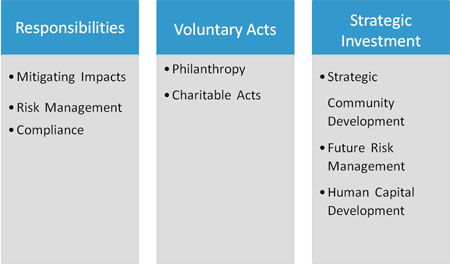
Putting these corporate activities into the business sphere of the firms, responsibility measures and strategic investments have direct impact on the core business activities sphere [including workplace, marketplace and the supply chain] of the firm. Firms can maximise their benefit by effectively incorporating both activities into their policies and activities. Intervention in society through philanthropic and charitable activities only depicts the voluntary acts of companies that do not hold any business benefits.
Firms involved in voluntary acts not only undermine their business competencies but also miss opportunities for future growth. By adding business perspectives to voluntary acts, firms have the ability to transform these acts into a strategic competitive tool for sustainable growth, deriving both agendas of delivering social benefit and also core business values from it. Moreover, firms have the competency of delivering better results by incorporating social concerns to their core business activities rather than just a philanthropic act. A company is most effective in social intervention when it incorporates social opportunities into its business sphere as its core business activities to create jobs, business opportunities, goods and services to sustain and improve living standards etc, besides being the main source of tax revenue.
It is necessary for leaders to understand the true spirit behind the development of the corporate responsibility approach and what it aims to provide. A rich literature and abundant knowledge has been developed on the corporate responsibility mechanism.
Breaking it down to its core dimensions, corporate responsibility aims to be a four dimensional, integrated and coherent approach to strategic management.
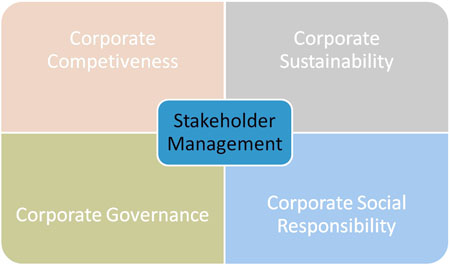
Adapted from 4CR Corporate Responsibilities Map
Stakeholder management is the focal point which provides the common link between multi dimensional perspectives of corporate responsibility. Unless all the above four dimensions are brought together under a common stakeholder management framework, corporate responsibility will remain peripheral to it principles and its impact is likely to be frail.
Corporate firms have managed to link corporate governance and social responsibility well with their corporate responsibility approach. That said, many firms seem to have misapprehended the concept of corporate social responsibility and have gone ahead into activities that involve philanthropy or charitable activities, rather than recognising it as a social opportunity.
Misapprehension of CSR; many corporate firms not recognising the true determination behind social development as a strategic competitiveness, have been focusing philanthropy activities devoid of their business interests.
Philanthropic activities undertaken by corporate firms have significant relevance to social and environmental issues raised by the humanitarian groups, and non-profit organisations. Intense pressures, consumer boycotts and regulatory threats have led to corporate firms realising their corporate social responsibility. But at the same time, constant contentious attitudes towards the corporate world and severe castigations focusing on one side of the impacts have put pressure on companies to pursue philanthropy activities to build up reputation in eyes of the watchdogs. Such strong actions have hindered the very essence of true social development approach, just by not reflecting the social impacts of the society on the company and the imperativeness of community development for company’s very own sustainable growth.
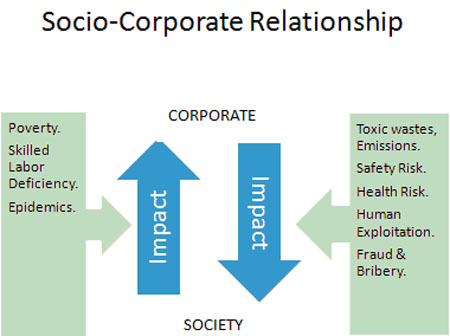
It is necessary for companies to realise that corporate contributions to sustainability must stem from self-interest and survival instincts.
We believe that the leading global companies of the future will be those that provide goods and services and reach new customers in ways that address the world’s major challenges – including poverty, climate change, resource depletion and globalisation. If action to address such issues is to be sustainable, it must also be profitable. Any company’s major contribution to society will therefore come through its core business, rather than through philanthropic activities. In an example General Electric has doubled its investment in clean technology, recognising that addressing climate change can be great business.
Corporate competitiveness not only shares companies’ financial responsibility for delivering profits but also as a spectrum to realise the fact that responsibility to foster sustainable future holds the imperativeness for economic and market growth. Sustainable growth of a company is embedded both to its products and services and market growth.
The question arises as to why social development is to be seen so important to firm’s own well-being. Why must it be seen as a strategic investment rather than just responsibility for remedy to firms’ impacts?
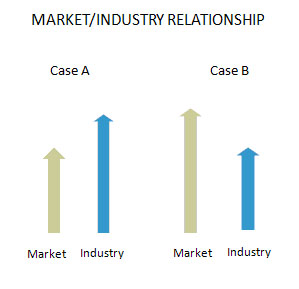
We have illustrated above two cases as to why social development must be seen as pivotal. Referring to the Case A, where future industry shows growth with maturity, on the other hand the pace of market growth may not equal to the industry. This may be the result of poverty, or educational/health insufficiency, epidemics etc. In an example, theelecom industry of Pakistan, at the moment, has outreached its potential market, leaving behind the poor part of society. Any growth in the sector has to stem from the social development of the unprivileged part becoming the potential customers of the industry.
Case B describes a future scenario where the market has grown over the years, whereas industry seems to be inadequate in providing products and services. This may be the result ofa lack of skilled labour, environmental restrictions, fulfilling consumer expectations etc. In an example, the shortage of information technology professionals is a significant constraint on Microsoft’s growth; currently, there are more than 450,000 unfilled IT positions in the United States only. Microsoft recognises the challenges faced and has invested $50 million over a five year initiative to address the inadequacy problems. In this context Microsoft has achieved results that have benefited many communities while having a direct and significant impact on the company.
In both cases, either the market not able to grow or the industry lagging behind is an issue that needs to be countered by the industries themselves. Therefore sustainable growth of the companies must not be seen as just industry’s own growth but also a parallel increase in the market growth also. Market growth is heavily embedded into social development of the market.
Firms only focus on the impacts of their activities (emissions etc) not realising the potential of investing in innovation, products addressing social and environmental issues and community development projects (industry related education, health etc), which are interrelated to the firm’s own development. Hence many firms adopting corporate responsibility strategy, which does not depict shared value benefits, are slowly jeopardising their own sustainable growth.
With regard to sustainability strategy away from risk management, we have identified nine steps (given below) that move the concept of corporate responsibility beyond the boundaries of compliance, public relations and philanthropy, to become a more integral part of corporate governance, strategy, risk management and reputation. Applied broadly, this values-driven approach offers companies new opportunities for value creation, benefiting not only shareholders, but employees, customers, communities and society at large.
- Pursue purpose beyond profit.
- People driven values.
- High standards of governance.
- Performance oriented approach.
- Innovation that responds to changing needs.
- Change at right time, right place.
- Spread economic opportunity.
- Partnerships and alliances.
- Transparency & Reporting.
1. Pursue purpose beyond Profit
The core purpose of any company is to provide goods and services that meet customer demands and yield a profit. However it also needs a vision, principles, and values for “a long-term sustainable return”. Together, purpose, principles and values encompass the shareholder interests, company growth and a will to do responsible business towards the betterment of the society at large. A blend of these concepts is what makes great companies stand out and do well by doing good.
Many companies envisaging their vision either define their business too narrowly into optimising returns for today that they miss new market opportunities, or at the other extreme take their business too broadly. That often takes them beyond their core competencies into activities they don’t benefit from. Therefore, it is important for companies to fit their purpose, principles and values accordingly to their business interests, ethical values and business competencies. An approach that companies can be successful by acting in the broader interests of society as a whole even while they satisfy the narrow interests of shareholders.
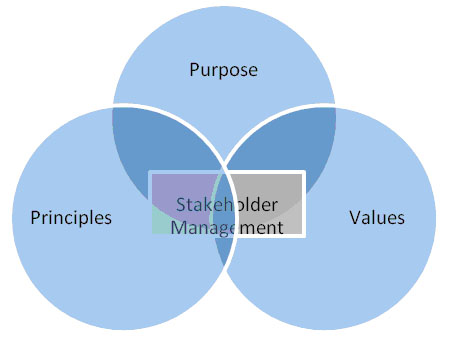
In an environment of increasing complexity, however, any extreme position is fatal for the company. Purpose and vision for any company must take a balanced approach and a mission to excel in both disciplines of profit maximisation and social benefit at large.
2. People Driven Values
In a time of a rapidly changing world, centralised management is not able to comprehensively understand end-user needs, competitive productivity, responsible behaviour, sustainable ecosystem or social importance by itself.
It is crucial forcompanies today to bring people to the centre that can contribute to create, analyse, distribute or provide knowledge on a broader spectrum. Therefore, today, many of the leading companies of the global business involve people who have distinctive experiences and knowledge to contribute something unique to the organisation. Corporate boardrooms of these companies involve people ranging from top management, employees and suppliers, to the customers and people from the society.
Thus, the company’s success and its ability to anticipate or respond to changing competitive circumstances and societal expectations leverages within the quality of relationships that it holds with its employees and other key stakeholders along its value chain.
3. High standards of governance
Our current economy is characterised by a focus on knowledge, change and globalisation. It is fast and unpredictable and driven by innovative and knowledge-based firms. These companies continuously seek to raise their standards of governance by developing and evolving their own understanding of managing risks, tackling bribery and corruption and ensuring transparency. They go beyond controlling risks, liabilities, costs and negative impacts into implementing management systems, metrics and audit compliances that improve their performances, encourage motivation, innovation and sustainable growth. Hence the success of these companies comes from their internal performance rather than just complying with external audits, compliances and metrics. Notable examples of superior corporate governance include companies like DuPont, General Motors, McDonalds, Nike, Rio Tinto, Ford Motor Company, GlaxoSmithKline and the Coca-Cola Company.
Over the past two decades DuPont has evolved legal, ethics and compliance programs and practices to ensure its employees operate according to corporate standards of behavior and within both local and industry laws and regulations. The DuPont ethics and compliance education program, internally branded “LegalEagleSM,” was developed in partnership with LRN to help further foster a corporate culture that ensures ethics as a fundamental corporate value. Since launching LegalEagle in 2003, more than 275,000 courses have been completed by DuPont employees on a variety of topics, including the DuPont Business Conduct Guide, antitrust, insider trading, careful communications and the importance of ethical business practices.
4. Performance oriented approach
Business success is linked to companies that can overcome the potential risk and become high performers. No matter how much an organisation redesigns, reconfigures, or reorganises for efficiency and productivity, high-performing people ultimately drive business results. These companies have a corporate culture that nurtures leaders, employees, suppliers who can think creatively, support high levels of teamwork, motivation to perform and pull the company in the same direction.
These high performance companies create top management systems, training programs and incentive structures, to create the performance driven culture that has a powerful impact on both top and bottom-line performance. However, this culture must not be restricted to internal stakeholders of the company, it should involve external stakeholders who are part of the corporate boardrooms. Prior to their membership, such stakeholders must be provided with trainings and informative sessions so that when they enter corporate boardrooms, these members are able to align their performance to the company’s goals and vision.
5. Innovation that responds to changing needs
Themost strategicapproach for strengthening the company’s sustainable growth comes through innovation in products, services, investment mechanisms, and even business opportunities (shared-value approach) that directly align social development needs with profit making.Innovation is the lifeblood of corporate competitiveness, value creation and sustainable growth. Innovation is vital to improving the quality of the products and services being provided and also to discover new ones that can provide competitive advantage. Innovation helps companies in the effort to mitigate the negative impacts of their products and also to come up with products that have value to their stakeholders at large.
Great companies, like Procter & Gamble, 3M, Toyota and DuPont, understand the immense opportunities and responsibilities of innovation. As a result, they go further than others by integrating ethical, social and environmental considerations into their R&D efforts. They carry out due diligence to minimise negative impacts. They also create new value by developing profitable customer solutions that meet emerging environmental, safety, and social needs, in addition to providing customers with good quality, reliability and value.
P&G is creating new shareholder and societal value by pursuing what it calls corporate social opportunity — the production of new products that improve customers’ lives while making important contributions to environmental quality and social well being. P&G’s PuR Water Purifier, for instance, a simple-to-use, low-cost water purifier developed in conjunction with the U.S.-based Centers for Disease Control and the International Council on Nurses, has the potential to save the lives of thousands of children who die each day in developing countries due in large parts to a lack of clean water.
6. Change at right time, right place
Continuous and rapid changes in the customer demands, social and environmental considerations, the development of laws and regulations, governments and international agencies influencing the shape of future business, puts companies in a mode to anticipate future paths and thrive for readiness to cope up with the challenges in time.
Toyota’s Global Vision 2010 program “Innovation into the Future: A Passion to Create a Better Society” was a transformation that resulted from anticipation of future shape of the automobile market. Toyota’s socially conscious transformation into a “driving force in global regeneration by implementing the most advanced environmental technologies” has turned out to be its competitive advantage in responding readily to changing markets with its on-time transformation. As the price of oil and gasoline rose to unprecedented levels, consumers demanding more economical and environmental-friendly cars, new regulations being exercised, Toyota had the capacity to respond, while most of its competitors were stuck selling low-mileage automobiles. Toyota set out to transform itself when most other automakers were declaring similar intentions during the past decade. Toyota transformed itself ahead of the curve, and thus was able to achieve what others could not: sustainable advantage over the competition.
The findings of a 1998 Corporate Strategy Board study: Only 17 percent of Fortune 50 companies that experienced a pronounced downturn in revenue growth during the 40 years covered by the research ever managed to return to high or even moderate growth. That failure proved costly: 69 percent of these companies lost at least half of their market capitalisation in the 10 years following their stall. The lesson for companies aspiring to be high-performance businesses: The best way to transform is from a position of strength and foresightedness.
That said, preparing yourself for early change to readiness is risky and requires the mastery of the point to change from. Change too soon or too often and it can be more disruptive than productive. Similarly change too late, incur downturn in the market share and losses, and recovery may no longer even be possible. Taking the example of Toyota, the company’s transformation a decade earlier than actually needed would have resulted in a position where the market for it would have not arose yet. On the other hand a change a decade after the actual transformation would have lead to competitive loss. Thus, a change must begin at a time where transformation takes place at the time the market demands it.
7. Spread economic opportunity
Business companies are the most powerful and effective engine for increasing prosperity and economic opportunity. But spreading economic opportunity must not be seen as a philanthropy act. Poverty poses the biggest threat to development of a global market. Providing economic opportunity is not only a poverty alleviation act about enabling a person to be able to feed himself, but also to empower him to become a future potential customer of the company’s product. Therefore, companies spreading economic opportunity are in fact building potential market growth for themselves in the future.
Mobilink GSM, a telecom company in Pakistan, has initiated a mobilink PCO project which has increased its customer outreach and at the same time spread an economic opportunity for poor people of Pakistan. Similarly, Starbucks one of the world’s most valuable brands, has started to spread economic opportunity, as well as environmental, social and quality standards, by working directly with small-scale coffee producers along its global supply chain, with awareness on pesticides and on yielding quality beans and buys them from small producers of those respective countries where it operates.
8. Partnerships & alliances.
Issues and development challenges that a company is not able to tackle or address on its own, where a company lacks financial, technical or informative resources, collaborative actions serve as a platform to effectively pursue such initiatives. Supporting educational reform, shifting markets towards more socially or environmentally sustainable paradigms, and ensuring industry wide ethical, social or environmental standards, and to avoid free-rider problems, are some challenges that require mutual initiatives and concerns for depletion. Firms can address certain development issues or challenges, either by engaging into collective corporate action or cross-sector alliances with other industries, non-profitable organisations, or governments.
Collective corporate alliances are driven by the core interest of the each partner in alliance sharing the same intent of deriving benefit from engagement (i.e. development of resources). Whereas cross-sector alliances are driven by addressing specific agenda (i.e. poverty alleviation) partnered in deriving different core purposes. Chevron Texaco is working with USAID, UNDP and others to support local economic development programs, and the Coca-Cola system is using its extensive distribution network to work in partnership with the UN and local partners to distribute public health messages and other services aimed at tackling HIV/Aids.
Unilever, for example, has embarked on a number of multi-stakeholder alliances over the past decade to support more sustainable fisheries and agricultural practices, and to provide affordable, good quality products to consumers in poor countries and consumers.
Private firms are at the heart of the development process. Driven by the quest for profits, firms of all types – from farmers and micro-entrepreneurs to local manufacturing companies and multinational enterprises – invest in new ideas and new facilities that strengthen the foundation of economic growth and prosperity. They provide more than 90% of jobs – creating opportunities for people to apply their talents and improve their situations. They provide the goods and services needed to sustain life and improve living standards. They are also the main source of tax revenues, contributing to public funding for health, education and other services. Firms are thus central actors in the quest for growth and poverty reduction – 2005 World Development Report; The World Bank
9. Transparency and reporting
Corporate reporting, over the years, has advanced from simply publishing financial performance to ethical, social and environmental performance of the companies. But companies still seem to be reluctant in being more transparent in addressing its performances. No longer is it enough for annual reports to have a philanthropic paragraph about the charity committee or about their fair trading and succinct introductions of environmental initiatives. Transparent and disclosure reporting needs to be exercised, with comprehensive figures, values, inputs, outputs and outcomes. Even if they don’t match expected performance, they must be revealed and published, with information on how and why things go wrong.
Reporting is not just a matter of attracting long-term investors, building reputation, providing shareholders and other stakeholders with confidence that the particular corporation is a well managed and responsible company. It must be performed with a strategic purpose to measure, analyse and enable forward-looking assessments to be made on such initiatives. Warren Buffet presenting the “Berkshire Hathaway’s” annual objectives explained what we are going to do, how we will measure it and how you can evaluate our performance this time next year.
Companies should present the sustainable goals the same way as they represent their financial objectives, and educate investors about the benefits of sustainability. Such reporting can help to assess policies, values and interventions of social and environmental opportunities. It is also helpful to those with social agendas for developing and innovating future strategies and initiatives for the benefit of the planet at large. In the research and development sector, students in universities can use such reports for their learning growth.
End-note
Sustainability without a real business case is mere philanthropy; without measurement, mere notion; without meaningful and transparent reporting, mere public relations. Today’s best-run companies – and smartest investors – are seeing sustainability for what it truly is: a strategic business driver that will separate the winners from the losers in the near future.
References
Niall Fitzgerald KBE and Mandy Cormack, “The Role of Business in Society” An agenda for action.
Ira A. Jackson and Jane Nelson, Ivey Business Journal, “Values-driven Performance: seven strategies for delivering profits with principles”.
“Business for Development”, World Business Council for Sustainable Development.
“From Challenge to Opportunity, the role of business in tomorrow’s society, World Business Council for Sustainable Development.
Jane nelson, “Leveraging the Development Impact of Business in the fight against Global Poverty”.
The Economist, journals/corporate management.
“Developing innovation leaders can be crucial to corporate competitiveness, growth”. Source Penn State.
“World Watch, Governance and corporate reporting” Issue 2, 2006.
Accenture/global/high performance business/the right place, the right time. As on 23 January 2008.